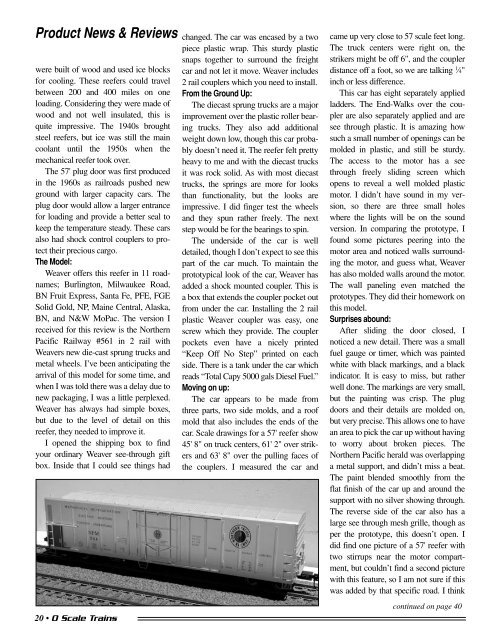More Color More Color - O scale trains
More Color More Color - O scale trains
More Color More Color - O scale trains
- No tags were found...
Create successful ePaper yourself
Turn your PDF publications into a flip-book with our unique Google optimized e-Paper software.
Product News & Reviewswere built of wood and used ice blocksfor cooling. These reefers could travelbetween 200 and 400 miles on oneloading. Considering they were made ofwood and not well insulated, this isquite impressive. The 1940s broughtsteel reefers, but ice was still the maincoolant until the 1950s when themechanical reefer took over.The 57' plug door was first producedin the 1960s as railroads pushed newground with larger capacity cars. Theplug door would allow a larger entrancefor loading and provide a better seal tokeep the temperature steady. These carsalso had shock control couplers to protecttheir precious cargo.The Model:Weaver offers this reefer in 11 roadnames;Burlington, Milwaukee Road,BN Fruit Express, Santa Fe, PFE, FGESolid Gold, NP, Maine Central, Alaska,BN, and N&W MoPac. The version Ireceived for this review is the NorthernPacific Railway #561 in 2 rail withWeavers new die-cast sprung trucks andmetal wheels. I’ve been anticipating thearrival of this model for some time, andwhen I was told there was a delay due tonew packaging, I was a little perplexed.Weaver has always had simple boxes,but due to the level of detail on thisreefer, they needed to improve it.I opened the shipping box to findyour ordinary Weaver see-through giftbox. Inside that I could see things had20 • O Scale Trainschanged. The car was encased by a twopiece plastic wrap. This sturdy plasticsnaps together to surround the freightcar and not let it move. Weaver includes2 rail couplers which you need to install.From the Ground Up:The diecast sprung trucks are a majorimprovement over the plastic roller bearingtrucks. They also add additionalweight down low, though this car probablydoesn’t need it. The reefer felt prettyheavy to me and with the diecast trucksit was rock solid. As with most diecasttrucks, the springs are more for looksthan functionality, but the looks areimpressive. I did finger test the wheelsand they spun rather freely. The nextstep would be for the bearings to spin.The underside of the car is welldetailed, though I don’t expect to see thispart of the car much. To maintain theprototypical look of the car, Weaver hasadded a shock mounted coupler. This isa box that extends the coupler pocket outfrom under the car. Installing the 2 railplastic Weaver coupler was easy, onescrew which they provide. The couplerpockets even have a nicely printed“Keep Off No Step” printed on eachside. There is a tank under the car whichreads “Total Capy 5000 gals Diesel Fuel.”Moving on up:The car appears to be made fromthree parts, two side molds, and a roofmold that also includes the ends of thecar. Scale drawings for a 57' reefer show45' 8" on truck centers, 61' 2" over strikersand 63' 8" over the pulling faces ofthe couplers. I measured the car andcame up very close to 57 <strong>scale</strong> feet long.The truck centers were right on, thestrikers might be off 6", and the couplerdistance off a foot, so we are talking 1 ⁄4"inch or less difference.This car has eight separately appliedladders. The End-Walks over the couplerare also separately applied and aresee through plastic. It is amazing howsuch a small number of openings can bemolded in plastic, and still be sturdy.The access to the motor has a seethrough freely sliding screen whichopens to reveal a well molded plasticmotor. I didn’t have sound in my version,so there are three small holeswhere the lights will be on the soundversion. In comparing the prototype, Ifound some pictures peering into themotor area and noticed walls surroundingthe motor, and guess what, Weaverhas also molded walls around the motor.The wall paneling even matched theprototypes. They did their homework onthis model.Surprises abound:After sliding the door closed, Inoticed a new detail. There was a smallfuel gauge or timer, which was paintedwhite with black markings, and a blackindicator. It is easy to miss, but ratherwell done. The markings are very small,but the painting was crisp. The plugdoors and their details are molded on,but very precise. This allows one to havean area to pick the car up without havingto worry about broken pieces. TheNorthern Pacific herald was overlappinga metal support, and didn’t miss a beat.The paint blended smoothly from theflat finish of the car up and around thesupport with no silver showing through.The reverse side of the car also has alarge see through mesh grille, though asper the prototype, this doesn’t open. Idid find one picture of a 57' reefer withtwo stirrups near the motor compartment,but couldn’t find a second picturewith this feature, so I am not sure if thiswas added by that specific road. I thinkcontinued on page 40
















